Abstract
BACKGROUND AND OBJECTIVES: Apolipoprotein E (apoE) has been implicated in regenerative processes in the brain after trauma, as well as in the pathogenesis of Alzheimer's disease. Inheritance of a specific apo epsilon allele (apo epsilon 4) determines in part the risk and the mean age at onset of Alzheimer's disease. ApoE has been found to bind isoform specifically to beta-amyloid protein, the major component of senile plaques, and to the microtubule associated protein tau, which forms paired helical filaments and neurofibrillary tangles. The aim was to further examine the relation between apo epsilon alleles, especially apo epsilon 4, and the development of neuropathological changes associated with Alzheimer's disease. METHODS: Brains of patients with Alzheimer's disease (n = 44) and vascular dementia (n = 11) and of age matched controls (n = 29) were studied. Senile plaques and neurofibrillary tangles in the hippocampus and frontal cortex were quantified. RESULTS: No correlation was found between the number of apo epsilon 4 alleles and the number of senile plaques and neurofibrillary tangles in the hippocampus or the frontal cortex of patients with Alzheimer's disease, or vascular dementia, or control groups. No significant differences in duration or severity of dementia were found between patients with or. without the apo epsilon 4 allele. No increased frequency of apo epsilon 4 was found in vascular dementia. CONCLUSION AND COMMENT: Although the apo epsilon genotype clearly affects whether Alzheimer's disease will develop or not, the present study suggests that it has no influence on pathology or clinical intellectual status, once the dementia has manifested itself. No increased apo epsilon 4 allele frequency was found in neuropathologically diagnosed patients with vascular dementia in whom concomitant Alzheimer's disease can be excluded.
Full text
PDF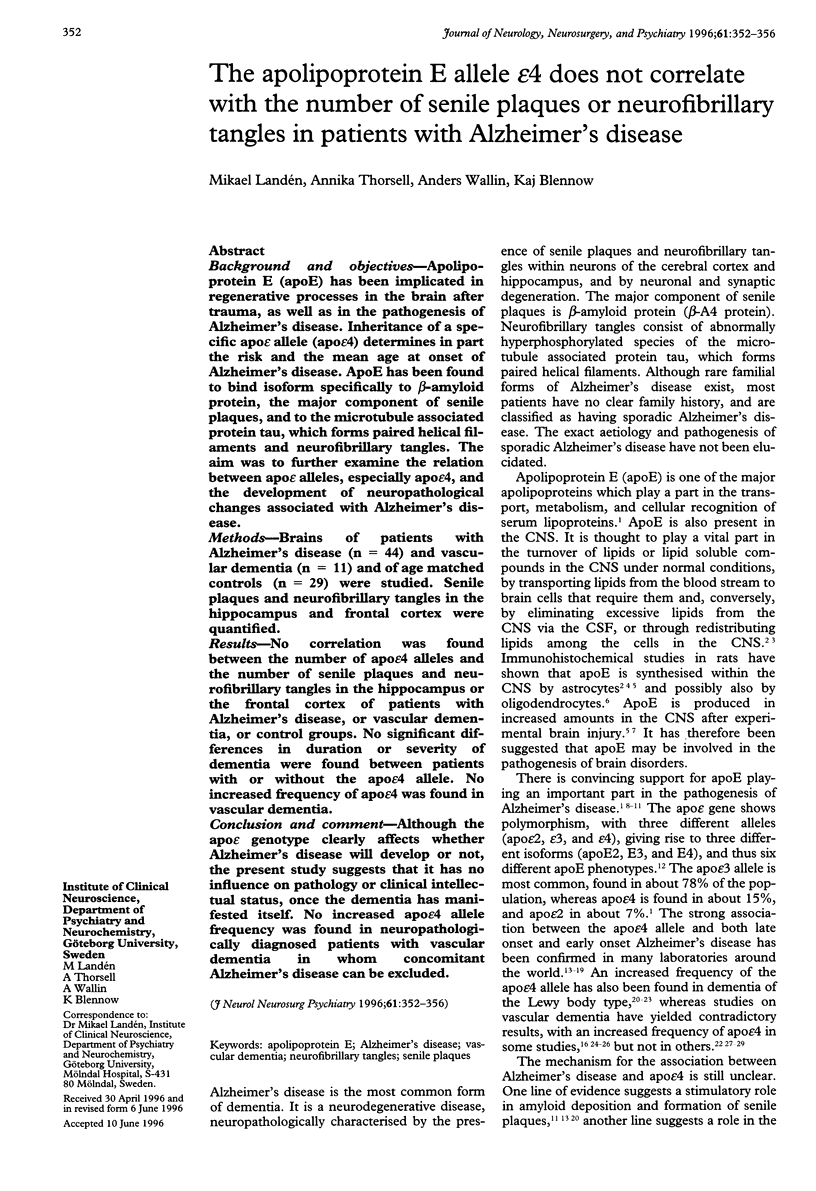
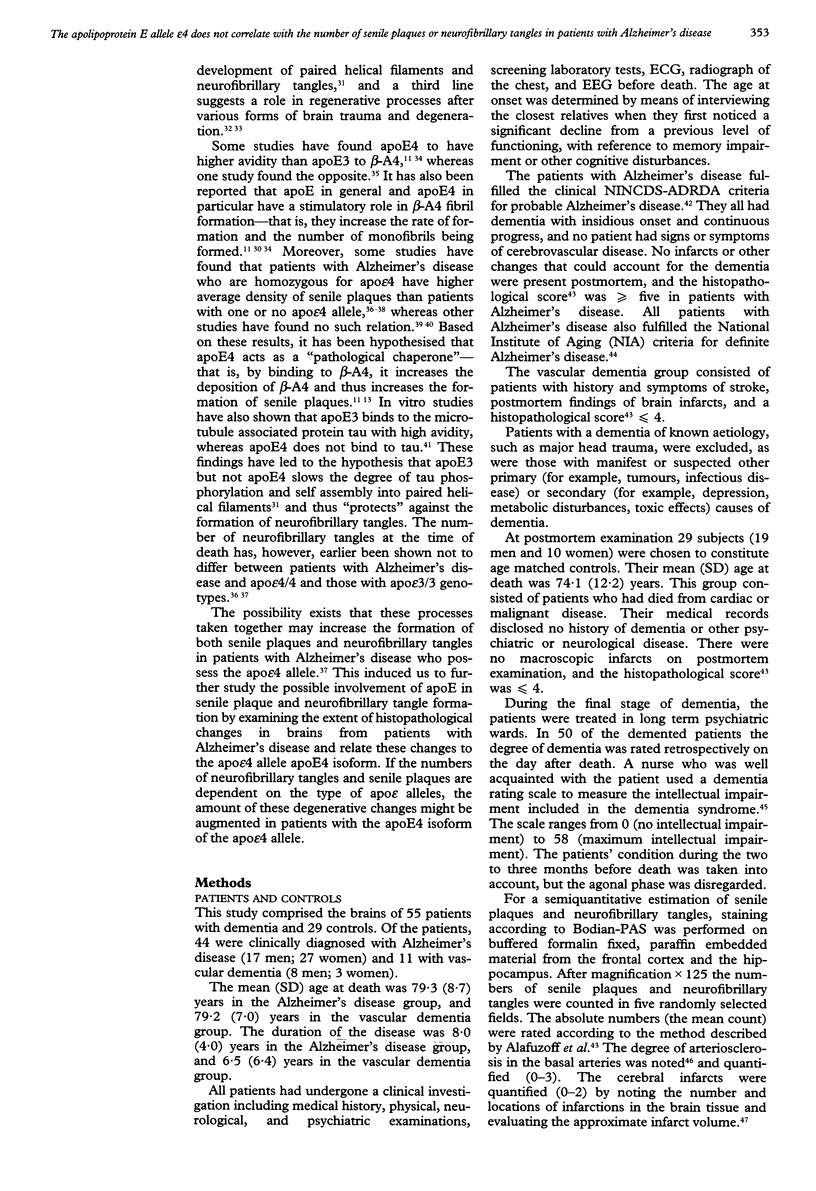
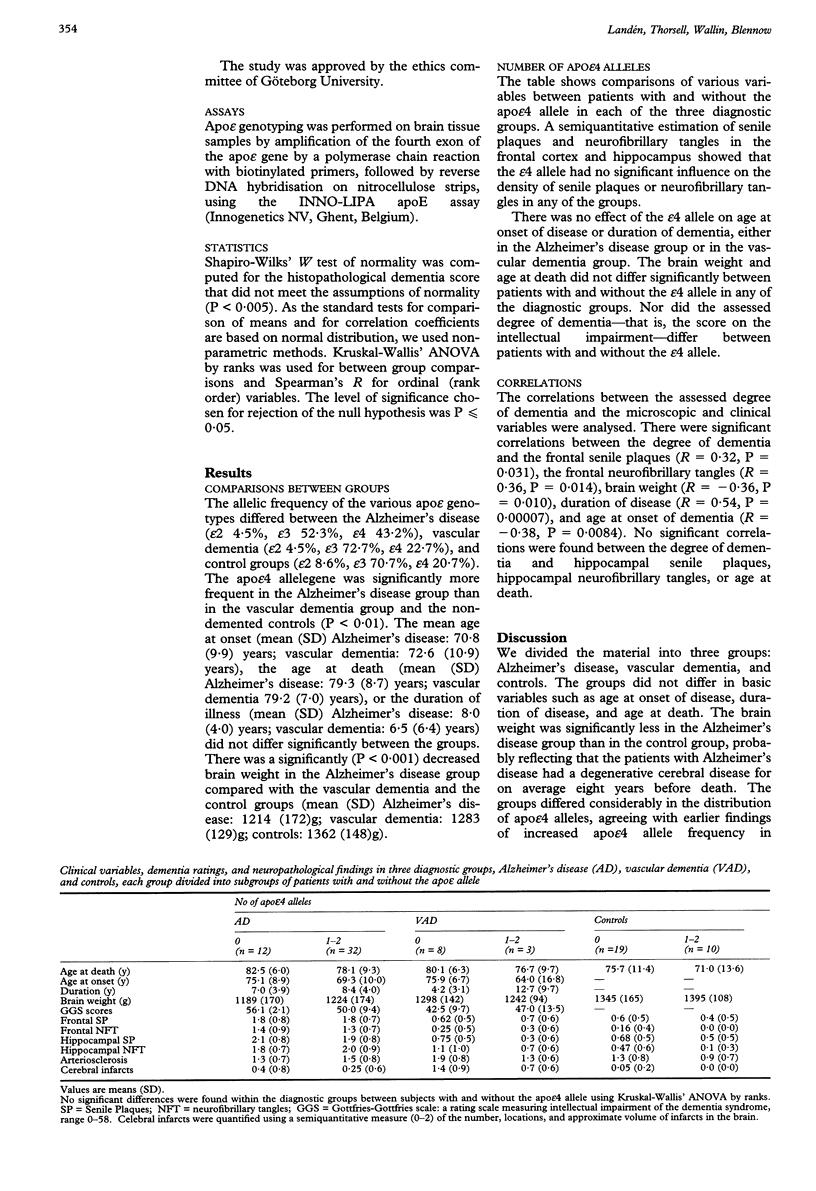
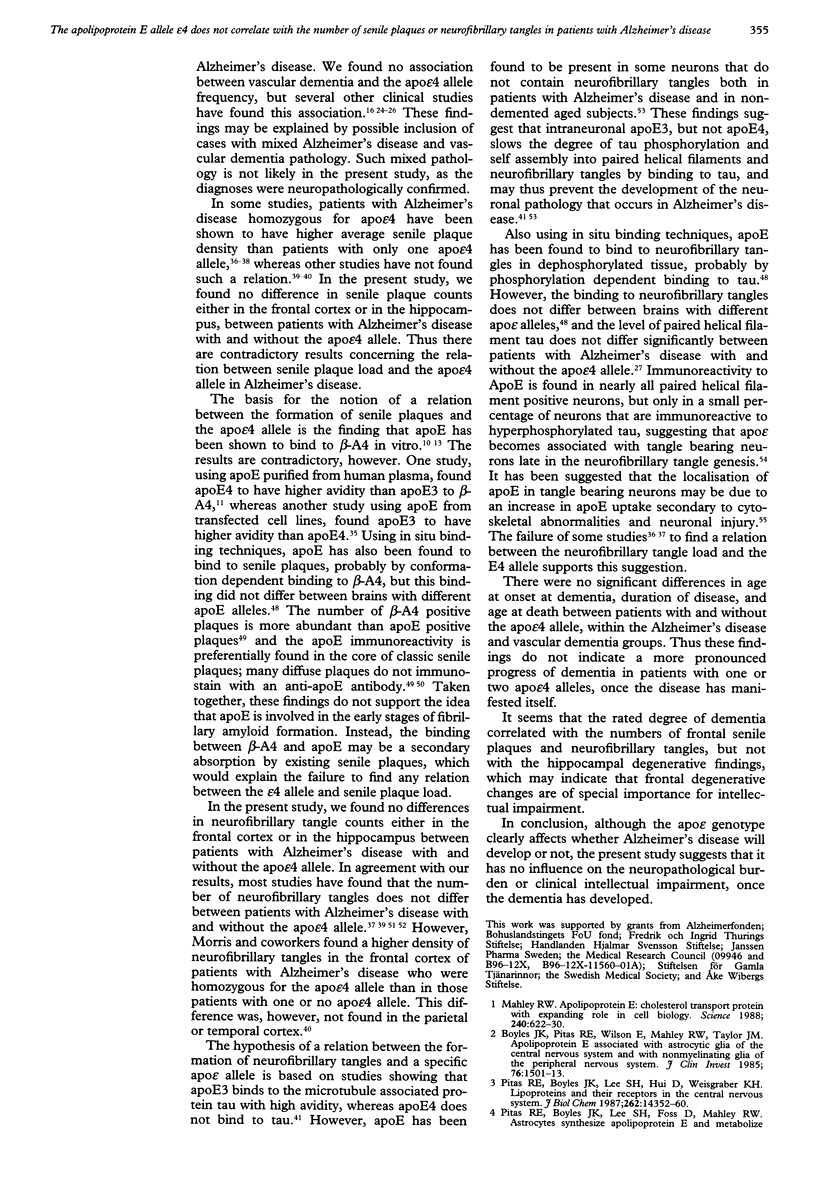
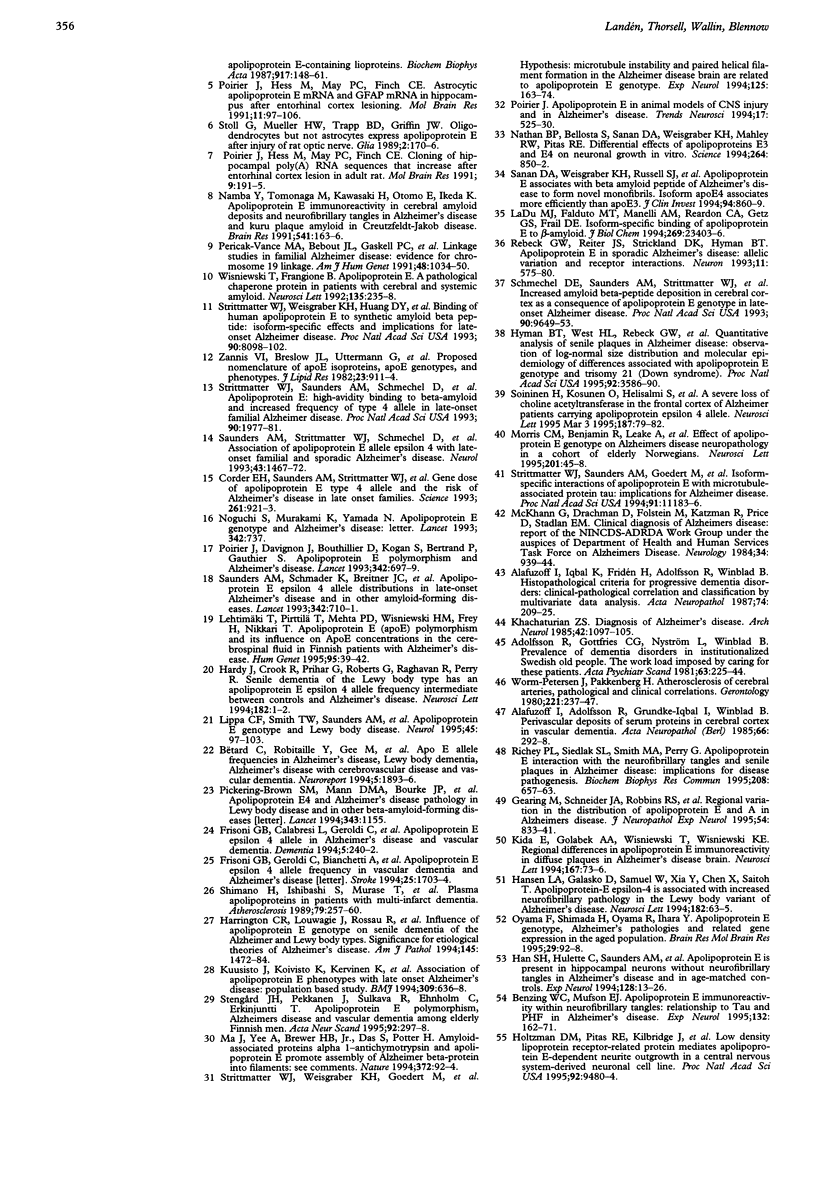
Selected References
These references are in PubMed. This may not be the complete list of references from this article.
- Adolfsson R., Gottfries C. G., Nyström L., Winblad B. Prevalence of dementia disorders in institutionalized Swedish old people. The work load imposed by caring for these patients. Acta Psychiatr Scand. 1981 Mar;63(3):225–244. doi: 10.1111/j.1600-0447.1981.tb00670.x. [DOI] [PubMed] [Google Scholar]
- Alafuzoff I., Adolfsson R., Grundke-Iqbal I., Winblad B. Perivascular deposits of serum proteins in cerebral cortex in vascular dementia. Acta Neuropathol. 1985;66(4):292–298. doi: 10.1007/BF00690961. [DOI] [PubMed] [Google Scholar]
- Alafuzoff I., Iqbal K., Friden H., Adolfsson R., Winblad B. Histopathological criteria for progressive dementia disorders: clinical-pathological correlation and classification by multivariate data analysis. Acta Neuropathol. 1987;74(3):209–225. doi: 10.1007/BF00688184. [DOI] [PubMed] [Google Scholar]
- Benzing W. C., Mufson E. J. Apolipoprotein E immunoreactivity within neurofibrillary tangles: relationship to Tau and PHF in Alzheimer's disease. Exp Neurol. 1995 Apr;132(2):162–171. doi: 10.1016/0014-4886(95)90021-7. [DOI] [PubMed] [Google Scholar]
- Boyles J. K., Pitas R. E., Wilson E., Mahley R. W., Taylor J. M. Apolipoprotein E associated with astrocytic glia of the central nervous system and with nonmyelinating glia of the peripheral nervous system. J Clin Invest. 1985 Oct;76(4):1501–1513. doi: 10.1172/JCI112130. [DOI] [PMC free article] [PubMed] [Google Scholar]
- Bétard C., Robitaille Y., Gee M., Tiberghien D., Larrivée D., Roy P., Mortimer J. A., Gauvreau D. Apo E allele frequencies in Alzheimer's disease, Lewy body dementia, Alzheimer's disease with cerebrovascular disease and vascular dementia. Neuroreport. 1994 Oct 3;5(15):1893–1896. doi: 10.1097/00001756-199410000-00013. [DOI] [PubMed] [Google Scholar]
- Corder E. H., Saunders A. M., Strittmatter W. J., Schmechel D. E., Gaskell P. C., Small G. W., Roses A. D., Haines J. L., Pericak-Vance M. A. Gene dose of apolipoprotein E type 4 allele and the risk of Alzheimer's disease in late onset families. Science. 1993 Aug 13;261(5123):921–923. doi: 10.1126/science.8346443. [DOI] [PubMed] [Google Scholar]
- Frisoni G. B., Calabresi L., Geroldi C., Bianchetti A., D'Acquarica A. L., Govoni S., Sirtori C. R., Trabucchi M., Franceschini G. Apolipoprotein E epsilon 4 allele in Alzheimer's disease and vascular dementia. Dementia. 1994 Sep-Oct;5(5):240–242. doi: 10.1159/000106730. [DOI] [PubMed] [Google Scholar]
- Frisoni G. B., Geroldi C., Bianchetti A., Trabucchi M., Govoni S., Franceschini G., Calabresi L. Apolipoprotein E epsilon 4 allele frequency in vascular dementia and Alzheimer's disease. Stroke. 1994 Aug;25(8):1703–1704. doi: 10.1161/01.str.25.8.1703. [DOI] [PubMed] [Google Scholar]
- Gearing M., Schneider J. A., Robbins R. S., Hollister R. D., Mori H., Games D., Hyman B. T., Mirra S. S. Regional variation in the distribution of apolipoprotein E and A beta in Alzheimer's disease. J Neuropathol Exp Neurol. 1995 Nov;54(6):833–841. doi: 10.1097/00005072-199511000-00010. [DOI] [PubMed] [Google Scholar]
- Han S. H., Hulette C., Saunders A. M., Einstein G., Pericak-Vance M., Strittmatter W. J., Roses A. D., Schmechel D. E. Apolipoprotein E is present in hippocampal neurons without neurofibrillary tangles in Alzheimer's disease and in age-matched controls. Exp Neurol. 1994 Jul;128(1):13–26. doi: 10.1006/exnr.1994.1108. [DOI] [PubMed] [Google Scholar]
- Hansen L. A., Galasko D., Samuel W., Xia Y., Chen X., Saitoh T. Apolipoprotein-E epsilon-4 is associated with increased neurofibrillary pathology in the Lewy body variant of Alzheimer's disease. Neurosci Lett. 1994 Nov 21;182(1):63–65. doi: 10.1016/0304-3940(94)90206-2. [DOI] [PubMed] [Google Scholar]
- Harrington C. R., Louwagie J., Rossau R., Vanmechelen E., Perry R. H., Perry E. K., Xuereb J. H., Roth M., Wischik C. M. Influence of apolipoprotein E genotype on senile dementia of the Alzheimer and Lewy body types. Significance for etiological theories of Alzheimer's disease. Am J Pathol. 1994 Dec;145(6):1472–1484. [PMC free article] [PubMed] [Google Scholar]
- Holtzman D. M., Pitas R. E., Kilbridge J., Nathan B., Mahley R. W., Bu G., Schwartz A. L. Low density lipoprotein receptor-related protein mediates apolipoprotein E-dependent neurite outgrowth in a central nervous system-derived neuronal cell line. Proc Natl Acad Sci U S A. 1995 Oct 10;92(21):9480–9484. doi: 10.1073/pnas.92.21.9480. [DOI] [PMC free article] [PubMed] [Google Scholar]
- Hyman B. T., West H. L., Rebeck G. W., Buldyrev S. V., Mantegna R. N., Ukleja M., Havlin S., Stanley H. E. Quantitative analysis of senile plaques in Alzheimer disease: observation of log-normal size distribution and molecular epidemiology of differences associated with apolipoprotein E genotype and trisomy 21 (Down syndrome). Proc Natl Acad Sci U S A. 1995 Apr 11;92(8):3586–3590. doi: 10.1073/pnas.92.8.3586. [DOI] [PMC free article] [PubMed] [Google Scholar]
- Khachaturian Z. S. Diagnosis of Alzheimer's disease. Arch Neurol. 1985 Nov;42(11):1097–1105. doi: 10.1001/archneur.1985.04060100083029. [DOI] [PubMed] [Google Scholar]
- Kida E., Golabek A. A., Wisniewski T., Wisniewski K. E. Regional differences in apolipoprotein E immunoreactivity in diffuse plaques in Alzheimer's disease brain. Neurosci Lett. 1994 Feb 14;167(1-2):73–76. doi: 10.1016/0304-3940(94)91030-8. [DOI] [PubMed] [Google Scholar]
- Kuusisto J., Koivisto K., Kervinen K., Mykkänen L., Helkala E. L., Vanhanen M., Hänninen T., Pyörälä K., Kesäniemi Y. A., Riekkinen P. Association of apolipoprotein E phenotypes with late onset Alzheimer's disease: population based study. BMJ. 1994 Sep 10;309(6955):636–638. doi: 10.1136/bmj.309.6955.636. [DOI] [PMC free article] [PubMed] [Google Scholar]
- LaDu M. J., Falduto M. T., Manelli A. M., Reardon C. A., Getz G. S., Frail D. E. Isoform-specific binding of apolipoprotein E to beta-amyloid. J Biol Chem. 1994 Sep 23;269(38):23403–23406. [PubMed] [Google Scholar]
- Lehtimäki T., Pirttilä T., Mehta P. D., Wisniewski H. M., Frey H., Nikkari T. Apolipoprotein E (apoE) polymorphism and its influence on ApoE concentrations in the cerebrospinal fluid in Finnish patients with Alzheimer's disease. Hum Genet. 1995 Jan;95(1):39–42. doi: 10.1007/BF00225071. [DOI] [PubMed] [Google Scholar]
- Mahley R. W. Apolipoprotein E: cholesterol transport protein with expanding role in cell biology. Science. 1988 Apr 29;240(4852):622–630. doi: 10.1126/science.3283935. [DOI] [PubMed] [Google Scholar]
- McKhann G., Drachman D., Folstein M., Katzman R., Price D., Stadlan E. M. Clinical diagnosis of Alzheimer's disease: report of the NINCDS-ADRDA Work Group under the auspices of Department of Health and Human Services Task Force on Alzheimer's Disease. Neurology. 1984 Jul;34(7):939–944. doi: 10.1212/wnl.34.7.939. [DOI] [PubMed] [Google Scholar]
- Namba Y., Tomonaga M., Kawasaki H., Otomo E., Ikeda K. Apolipoprotein E immunoreactivity in cerebral amyloid deposits and neurofibrillary tangles in Alzheimer's disease and kuru plaque amyloid in Creutzfeldt-Jakob disease. Brain Res. 1991 Feb 8;541(1):163–166. doi: 10.1016/0006-8993(91)91092-f. [DOI] [PubMed] [Google Scholar]
- Nathan B. P., Bellosta S., Sanan D. A., Weisgraber K. H., Mahley R. W., Pitas R. E. Differential effects of apolipoproteins E3 and E4 on neuronal growth in vitro. Science. 1994 May 6;264(5160):850–852. doi: 10.1126/science.8171342. [DOI] [PubMed] [Google Scholar]
- Noguchi S., Murakami K., Yamada N. Apolipoprotein E genotype and Alzheimer's disease. Lancet. 1993 Sep 18;342(8873):737–737. doi: 10.1016/0140-6736(93)91728-5. [DOI] [PubMed] [Google Scholar]
- Pericak-Vance M. A., Bebout J. L., Gaskell P. C., Jr, Yamaoka L. H., Hung W. Y., Alberts M. J., Walker A. P., Bartlett R. J., Haynes C. A., Welsh K. A. Linkage studies in familial Alzheimer disease: evidence for chromosome 19 linkage. Am J Hum Genet. 1991 Jun;48(6):1034–1050. [PMC free article] [PubMed] [Google Scholar]
- Pickering-Brown S. M., Mann D. M., Bourke J. P., Roberts D. A., Balderson D., Burns A., Byrne J., Owen F. Apolipoprotein E4 and Alzheimer's disease pathology in Lewy body disease and in other beta-amyloid-forming diseases. Lancet. 1994 May 7;343(8906):1155–1155. doi: 10.1016/s0140-6736(94)90257-7. [DOI] [PubMed] [Google Scholar]
- Pitas R. E., Boyles J. K., Lee S. H., Foss D., Mahley R. W. Astrocytes synthesize apolipoprotein E and metabolize apolipoprotein E-containing lipoproteins. Biochim Biophys Acta. 1987 Jan 13;917(1):148–161. doi: 10.1016/0005-2760(87)90295-5. [DOI] [PubMed] [Google Scholar]
- Pitas R. E., Boyles J. K., Lee S. H., Hui D., Weisgraber K. H. Lipoproteins and their receptors in the central nervous system. Characterization of the lipoproteins in cerebrospinal fluid and identification of apolipoprotein B,E(LDL) receptors in the brain. J Biol Chem. 1987 Oct 15;262(29):14352–14360. [PubMed] [Google Scholar]
- Poirier J. Apolipoprotein E in animal models of CNS injury and in Alzheimer's disease. Trends Neurosci. 1994 Dec;17(12):525–530. doi: 10.1016/0166-2236(94)90156-2. [DOI] [PubMed] [Google Scholar]
- Poirier J., Davignon J., Bouthillier D., Kogan S., Bertrand P., Gauthier S. Apolipoprotein E polymorphism and Alzheimer's disease. Lancet. 1993 Sep 18;342(8873):697–699. doi: 10.1016/0140-6736(93)91705-q. [DOI] [PubMed] [Google Scholar]
- Poirier J., Hess M., May P. C., Finch C. E. Astrocytic apolipoprotein E mRNA and GFAP mRNA in hippocampus after entorhinal cortex lesioning. Brain Res Mol Brain Res. 1991 Sep;11(2):97–106. doi: 10.1016/0169-328x(91)90111-a. [DOI] [PubMed] [Google Scholar]
- Poirier J., Hess M., May P. C., Finch C. E. Cloning of hippocampal poly(A) RNA sequences that increase after entorhinal cortex lesion in adult rat. Brain Res Mol Brain Res. 1991 Feb;9(3):191–195. doi: 10.1016/0169-328x(91)90002-f. [DOI] [PubMed] [Google Scholar]
- Richey P. L., Siedlak S. L., Smith M. A., Perry G. Apolipoprotein E interaction with the neurofibrillary tangles and senile plaques in Alzheimer disease: implications for disease pathogenesis. Biochem Biophys Res Commun. 1995 Mar 17;208(2):657–663. doi: 10.1006/bbrc.1995.1389. [DOI] [PubMed] [Google Scholar]
- Sanan D. A., Weisgraber K. H., Russell S. J., Mahley R. W., Huang D., Saunders A., Schmechel D., Wisniewski T., Frangione B., Roses A. D. Apolipoprotein E associates with beta amyloid peptide of Alzheimer's disease to form novel monofibrils. Isoform apoE4 associates more efficiently than apoE3. J Clin Invest. 1994 Aug;94(2):860–869. doi: 10.1172/JCI117407. [DOI] [PMC free article] [PubMed] [Google Scholar]
- Saunders A. M., Schmader K., Breitner J. C., Benson M. D., Brown W. T., Goldfarb L., Goldgaber D., Manwaring M. G., Szymanski M. H., McCown N. Apolipoprotein E epsilon 4 allele distributions in late-onset Alzheimer's disease and in other amyloid-forming diseases. Lancet. 1993 Sep 18;342(8873):710–711. doi: 10.1016/0140-6736(93)91709-u. [DOI] [PubMed] [Google Scholar]
- Saunders A. M., Strittmatter W. J., Schmechel D., George-Hyslop P. H., Pericak-Vance M. A., Joo S. H., Rosi B. L., Gusella J. F., Crapper-MacLachlan D. R., Alberts M. J. Association of apolipoprotein E allele epsilon 4 with late-onset familial and sporadic Alzheimer's disease. Neurology. 1993 Aug;43(8):1467–1472. doi: 10.1212/wnl.43.8.1467. [DOI] [PubMed] [Google Scholar]
- Schmechel D. E., Saunders A. M., Strittmatter W. J., Crain B. J., Hulette C. M., Joo S. H., Pericak-Vance M. A., Goldgaber D., Roses A. D. Increased amyloid beta-peptide deposition in cerebral cortex as a consequence of apolipoprotein E genotype in late-onset Alzheimer disease. Proc Natl Acad Sci U S A. 1993 Oct 15;90(20):9649–9653. doi: 10.1073/pnas.90.20.9649. [DOI] [PMC free article] [PubMed] [Google Scholar]
- Shimano H., Ishibashi S., Murase T., Gotohda T., Yamada N., Takaku F., Ohtomo E. Plasma apolipoproteins in patients with multi-infarct dementia. Atherosclerosis. 1989 Oct;79(2-3):257–260. doi: 10.1016/0021-9150(89)90132-9. [DOI] [PubMed] [Google Scholar]
- Soininen H., Kosunen O., Helisalmi S., Mannermaa A., Paljärvi L., Talasniemi S., Ryynänen M., Riekkinen P., Sr A severe loss of choline acetyltransferase in the frontal cortex of Alzheimer patients carrying apolipoprotein epsilon 4 allele. Neurosci Lett. 1995 Mar 3;187(2):79–82. doi: 10.1016/0304-3940(95)11343-6. [DOI] [PubMed] [Google Scholar]
- Stengård J. H., Pekkanen J., Sulkava R., Ehnholm C., Erkinjuntti T., Nissinen A. Apolipoprotein E polymorphism, Alzheimer's disease and vascular dementia among elderly Finnish men. Acta Neurol Scand. 1995 Oct;92(4):297–298. doi: 10.1111/j.1600-0404.1995.tb00132.x. [DOI] [PubMed] [Google Scholar]
- Stoll G., Meuller H. W., Trapp B. D., Griffin J. W. Oligodendrocytes but not astrocytes express apolipoprotein E after injury of rat optic nerve. Glia. 1989;2(3):170–176. doi: 10.1002/glia.440020306. [DOI] [PubMed] [Google Scholar]
- Strittmatter W. J., Saunders A. M., Goedert M., Weisgraber K. H., Dong L. M., Jakes R., Huang D. Y., Pericak-Vance M., Schmechel D., Roses A. D. Isoform-specific interactions of apolipoprotein E with microtubule-associated protein tau: implications for Alzheimer disease. Proc Natl Acad Sci U S A. 1994 Nov 8;91(23):11183–11186. doi: 10.1073/pnas.91.23.11183. [DOI] [PMC free article] [PubMed] [Google Scholar]
- Strittmatter W. J., Saunders A. M., Schmechel D., Pericak-Vance M., Enghild J., Salvesen G. S., Roses A. D. Apolipoprotein E: high-avidity binding to beta-amyloid and increased frequency of type 4 allele in late-onset familial Alzheimer disease. Proc Natl Acad Sci U S A. 1993 Mar 1;90(5):1977–1981. doi: 10.1073/pnas.90.5.1977. [DOI] [PMC free article] [PubMed] [Google Scholar]
- Strittmatter W. J., Weisgraber K. H., Goedert M., Saunders A. M., Huang D., Corder E. H., Dong L. M., Jakes R., Alberts M. J., Gilbert J. R. Hypothesis: microtubule instability and paired helical filament formation in the Alzheimer disease brain are related to apolipoprotein E genotype. Exp Neurol. 1994 Feb;125(2):163–174. doi: 10.1006/exnr.1994.1019. [DOI] [PubMed] [Google Scholar]
- Strittmatter W. J., Weisgraber K. H., Huang D. Y., Dong L. M., Salvesen G. S., Pericak-Vance M., Schmechel D., Saunders A. M., Goldgaber D., Roses A. D. Binding of human apolipoprotein E to synthetic amyloid beta peptide: isoform-specific effects and implications for late-onset Alzheimer disease. Proc Natl Acad Sci U S A. 1993 Sep 1;90(17):8098–8102. doi: 10.1073/pnas.90.17.8098. [DOI] [PMC free article] [PubMed] [Google Scholar]
- Wisniewski T., Frangione B. Apolipoprotein E: a pathological chaperone protein in patients with cerebral and systemic amyloid. Neurosci Lett. 1992 Feb 3;135(2):235–238. doi: 10.1016/0304-3940(92)90444-c. [DOI] [PubMed] [Google Scholar]


